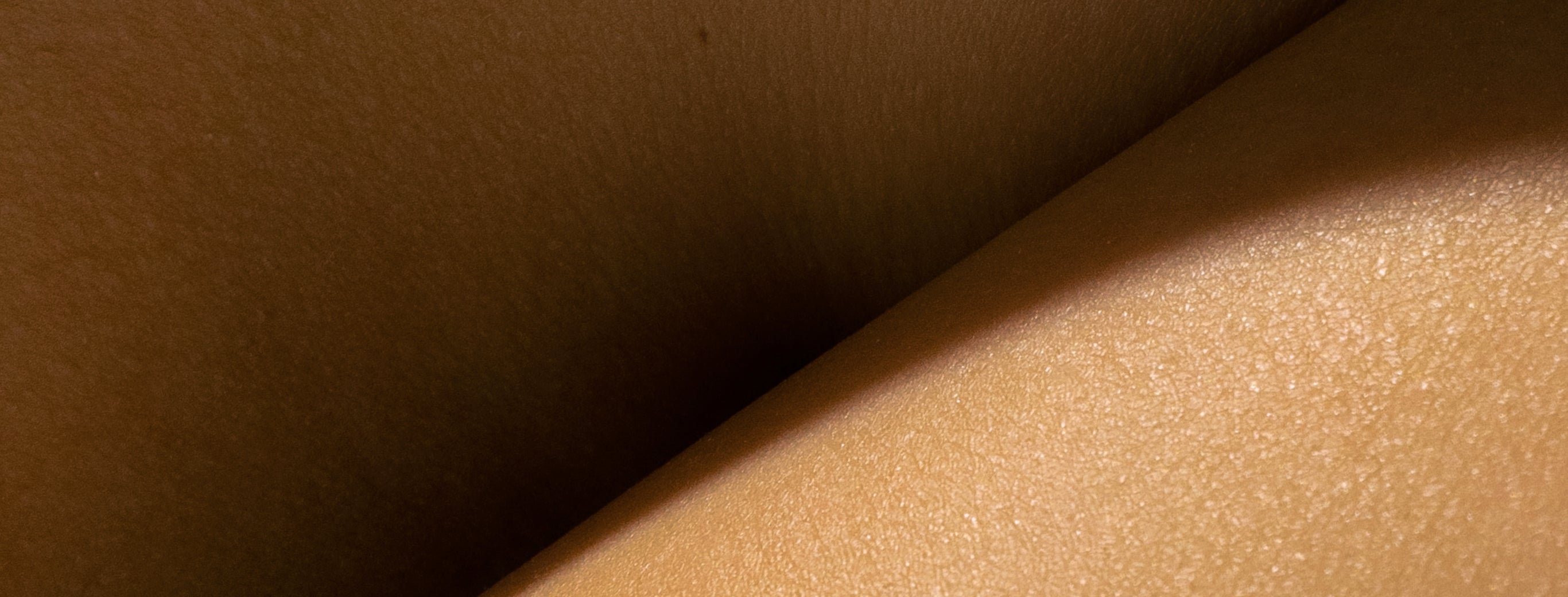Stages of Swelling After a Tummy Tuck: Everything You Need to Know

Because nobody warned you that your belly would look like you smuggled a watermelon – but don't worry, we've got your back (and your front)
So, you've finally done it. You've taken the plunge into the world of tummy tucks, ready to emerge like a butterfly from your surgical cocoon with the flat, toned abdomen of your dreams. You've researched surgeons, saved your pennies, and mentally prepared for your transformation. But here's what nobody really prepared you for: the swelling saga that follows.
If you're currently staring down at your post-surgery belly wondering if your surgeon accidentally inflated you like a balloon animal, take a deep breath (as deep as those compression garments will allow) and know that you're not alone. Swelling after a tummy tuck isn't just common – it's practically guaranteed. And while it might feel like your abdomen has developed its own weather system, complete with fluid retention storms and inflammation fronts, this is actually your body doing exactly what it's supposed to do.
Welcome to the wild, wonderful, and sometimes bewildering world of post-tummy tuck recovery, where patience isn't just a virtue – it's a survival skill.
The Science Behind the Swell: Why Your Body Throws This Curveball
Before we dive into the timeline of your swelling journey, let's talk about why this happens in the first place. Think of swelling as your body's overly enthusiastic security team. When your surgeon makes those precise incisions and removes excess skin and fat, your body's alarm bells start ringing louder than a smoke detector with a low battery.
"Code red! We've got tissue trauma! All hands on deck!"
Your immune system immediately springs into action, sending white blood cells, plasma, and other healing compounds rushing to the surgical site. This biological cavalry charge is accompanied by increased blood flow and fluid retention – your body's way of creating the perfect healing environment. The problem? This perfect healing environment happens to look a lot like you've hidden several soup cans under your skin.
The swelling occurs because your lymphatic system – essentially your body's drainage network – gets temporarily disrupted during surgery. Think of it like construction work blocking your neighborhood's storm drains during a rainstorm. The water (in this case, lymphatic fluid) has nowhere to go, so it pools where it can. Add to this the fact that your abdominal muscles have been tightened and repositioned, and you've got a recipe for significant, albeit temporary, puffiness.
This inflammatory response is actually a sign that your body is working hard to heal you. But knowing that doesn't make it any less frustrating when your pre-surgery jeans laugh at you from the closet.
Stages of Tummy Tuck Swelling
Stage One: The "What Have I Done?" Phase (Week 1)
Peak swelling period, peak panic period
Welcome to week one, where your abdomen has seemingly transformed into its own time zone and gravity seems to be working overtime in your midsection. This is peak swelling territory, and if you're feeling like you've been inflated by an overzealous party clown, you're right on schedule.
During the first 72 to 96 hours post-surgery, your swelling will be at its most dramatic. Your abdomen may feel firm, tight, and possibly warm to the touch. Don't be alarmed if you look like you're carrying twins – this is completely normal and temporary, even though it doesn't feel temporary when you're living through it.
What's happening inside:
Your body is in full-scale emergency response mode. Blood vessels are dilated, allowing maximum healing compounds to flood the area. Your lymphatic system is working overtime but struggling to keep up with the demand. Meanwhile, those newly tightened abdominal muscles are protesting their new arrangement by retaining every drop of fluid they can find.
What you might experience:
-
Significant abdominal distension that makes you look several months pregnant
-
Tightness that makes bending feel impossible
-
Bruising that creates a rainbow of colors across your torso
-
General discomfort that makes finding a comfortable position challenging
-
Emotional ups and downs (because who doesn't feel vulnerable when they look like they're smuggling produce?)
Your survival toolkit:
Compression garments are your new best friend. Yes, they're uncomfortable. Yes, they make you feel like a sausage. But they're working 24/7 to minimize swelling and support your healing tissues. Think of them as your personal swelling security team.
Elevation is key. Keep your upper body slightly elevated when resting and sleeping. Gravity is not your friend right now, so don't give it any advantages. Consider a tummy tuck pillow designed specifically to keep your body snug and safe in an elevated sleeping position all night and during rest.
Hydration station. It seems counterintuitive, but drinking plenty of water actually helps reduce fluid retention. Your body holds onto water when it thinks there's a shortage, so keep it reassured with consistent hydration.
Gentle movement. Short, slow walks help stimulate lymphatic drainage. You're not training for a marathon – you're just reminding your circulation system to keep moving.
Stage Two: The "Slow and Steady" Phase (Weeks 2-4)
Where hope begins to bloom, but patience is still required
By week two, you might start to notice that your abdomen isn't quite as firm as a basketball anymore. Progress! This is when many people begin to see the light at the end of the swelling tunnel, though that light might still seem pretty far away.
The good news is that the acute inflammatory response is beginning to calm down. Your body has assessed the situation, decided you're not actually under attack, and started to dial back the emergency protocols. The bad news? You're still going to look puffy, especially by the end of the day.
What's happening inside:
Your lymphatic system is starting to establish new drainage pathways around the surgical site. Blood flow is normalizing, and your immune system is shifting from "panic mode" to "renovation mode." However, scar tissue is beginning to form, which can temporarily trap some fluid as your body figures out its new normal.
What you might experience:
-
Noticeable reduction in morning swelling
-
Increased puffiness by evening (hello, gravity!)
-
Improved comfort when walking and moving
-
The beginning of your actual results starting to peek through
-
Renewed optimism mixed with impatience
Your survival toolkit:
Continue the compression garment relationship. You might be tempted to give yourself breaks, but consistency is key during this phase.
Introduce gentle massage. Light, upward strokes can help encourage lymphatic drainage. Think spa-gentle, not deep-tissue aggressive.
Monitor your activity levels. You might feel better, but your body is still healing. Too much too soon can cause setbacks in swelling reduction.
Nutritional support becomes crucial. This is where targeted nutrition can make a significant difference in your healing trajectory.
Stage Three: The "Getting Somewhere" Phase (Weeks 4-8)
When you start to remember why you did this in the first place
This is often the phase where people start to feel human again. The major swelling has subsided, and you're beginning to see glimpses of your final results. However, residual swelling can still be noticeable, particularly in the lower abdomen and around the incision site.
What's happening inside:
Your body has established new circulation patterns and is efficiently removing excess fluid. Scar tissue is maturing and softening, allowing for better fluid movement. Your abdominal muscles are adapting to their new position, and the healing process is becoming more refined and targeted.
What you might experience:
-
Significantly improved comfort and mobility
-
More consistent results throughout the day
-
The ability to wear some of your regular clothes (though you might still need those forgiving fabrics)
-
Increased confidence in your recovery progress
-
Occasional swelling flare-ups that remind you you're still healing
Your survival toolkit:
Gradual activity increase.
You can start to introduce more movement, but listen to your body's feedback.
Continued compression as needed.
Some people benefit from wearing their garments during particularly active days.
Scar care begins.
Proper scar management can help prevent long-term swelling issues.
Patience with the process.
This is often when people get impatient because they're feeling so much better, but the final stages of healing still require time.
Stage Four: The "Home Stretch" Phase (3-6 months)
Where patience pays off and results reveal themselves
By the three-month mark, most of the swelling has resolved, and you're beginning to see your true results. However, some subtle swelling may persist, particularly if you've had extensive work done. This is the phase where the magic really starts to happen – where all that patience and careful recovery work pays off.
What's happening inside:
Your body has fully adapted to its new contours. Circulation is back to normal, scar tissue has matured, and any remaining swelling is minimal and localized. Your lymphatic system has fully compensated for the surgical changes, and healing is in its final phases.
What you might experience:
-
Minimal, mostly unnoticeable swelling
-
True representation of your final results
-
Comfort in fitted clothing
-
Renewed confidence in your body
-
Occasional minor swelling with hormonal changes or increased sodium intake
Your survival toolkit:
Maintenance mode nutrition.
Continue supporting your body with good nutrition for optimal long-term results.
Regular activity.
Exercise helps maintain results and supports continued good circulation.
Body awareness.
You'll learn to recognize the subtle signs that might indicate minor swelling flare-ups.
Celebration.
You've made it through the challenging phases – acknowledge your perseverance!

The Tummy Tuck Game-Changer: Why Nutrition Matters More Than You Think
Here's where most recovery guides stop, but we're just getting to the good part. While compression garments, rest, and time are essential components of managing post-tummy tuck swelling, there's one factor that can significantly accelerate your recovery and minimize swelling: targeted nutritional support.
Your body is essentially running a major construction project after surgery, and construction projects require the right materials. You wouldn't try to build a house with cardboard and hope, yet many people approach surgical recovery with whatever happens to be in their pantry.
The truth is, your body needs specific nutrients in specific amounts to optimize healing and minimize swelling. We're talking about amino acids for tissue repair, anti-inflammatory compounds to calm the swelling response, and micronutrients that support your lymphatic system's drainage function.
This is where Before + After Vitals enters the conversation – not as just another supplement, but as a targeted nutritional strategy specifically designed for surgical recovery.

SHOP BEFORE + AFTER VITALS FOR SWELLING AFTER YOUR TUMMY TUCK
Before + After Vitals: The Swiss Army Knife of Surgical Recovery
Created by a clinical dietitian who worked directly with plastic surgery patients, Before + After Vitals isn't your typical protein powder or vitamin collection. It's a comprehensive nutritional system designed specifically to address the unique challenges of cosmetic surgery recovery – including that frustrating swelling we've been discussing.
The Swelling-Fighting Arsenal:
BioEnhanced Vitamin C:
This isn't the vitamin C you remember from childhood. This patented formulation has 233% higher retention by the human body than traditional vitamin C supplements and is specifically designed to reduce inflammation without the digestive upset that can come with high-dose vitamin C. Less inflammation equals less swelling – it's that simple.
Proteolytic Enzymes:
These patented enzymes don't just help you absorb protein better (though they do that too). They actively work to break down inflammatory compounds that contribute to swelling, essentially giving your body's natural anti-inflammatory processes a significant boost.
Hydrolyzed Collagen:
While everyone talks about collagen for skin health, the hydrolyzed form in Before + After Vitals specifically targets skin elasticity and structure. Clinical studies show up to 15% improvement in skin elasticity in just four weeks – crucial for helping your newly contoured skin adapt to its new shape without excess fluid retention.
Biome Synbiotics:
Here's something most people don't know – your gut health directly impacts your body's ability to manage inflammation and swelling. The patented prebiotic and probiotic blend in Before + After Vitals supports healthy gut function, which in turn supports your body's anti-inflammatory response and helps maintain optimal fluid balance.
Strategic Amino Acids:
L-Glutamine, L-Citrulline, and L-Arginine work together to support tissue repair, regulate blood flow, and help manage the transfer of electrolytes from blood to tissue – directly addressing one of the primary mechanisms behind post-surgical swelling.
The Mineral Dream Team:
Zinc, copper, and manganese in chelated forms (meaning they're bound to amino acids for better absorption) work specifically to support wound healing and tissue repair while helping maintain proper fluid balance.
Beyond the Scoop: A Complete Recovery System
Sulinu isn't just about what's in the scoop – it's about providing a complete nutritional strategy for surgical recovery. The system includes pre and post op meal plans that complement nutrient loading, taking the guesswork out of recovery nutrition.
Because here's the thing: you can have the best surgeon in the world and follow every post-operative instruction perfectly, but if your body doesn't have the raw materials it needs to heal efficiently, you're fighting an uphill battle against swelling and prolonged recovery.
The Smart Approach to Swelling Management
Managing post-tummy tuck swelling isn't just about waiting it out – it's about actively supporting your body's healing processes. This means:
Starting before surgery:
Pre-loading your system with the nutrients it will need for optimal healing
Continuing through recovery:
Providing consistent nutritional support during the most critical healing phases
Supporting long-term:
Maintaining the nutritional habits that support your results
The combination of targeted nutrition, proper compression, appropriate activity, and patience creates a recovery environment where swelling resolves more quickly and efficiently.
Your Swelling Survival Guide: Practical Tips for Every Stage
Week 1: Embrace the Puff
-
Accept that you will look swollen – this is normal and temporary
-
Focus on proper hydration and nutrition
-
Use compression garments consistently
-
Rest when your body tells you to rest
-
Start your nutritional support immediately, if you haven’t already
Weeks 2-4: Trust the Process
-
Continue nutritional support – this is when it matters most
-
Introduce gentle movement and massage
-
Don't compare your day-to-day progress – look at week-to-week changes
-
Stay patient with the timeline
Weeks 4-8: See the Light
-
Maintain consistency with your recovery protocol
-
Start planning your celebration outfit
-
Continue supporting your body nutritionally
-
Trust that the final results are coming
Months 3-6: Enjoy the Results
-
Maintain good nutritional habits for long-term success
-
Celebrate your perseverance through the recovery process
-
Share your experience to help others going through the same journey
The Bottom Line: Your Swelling Story Has a Happy Ending
Post-tummy tuck swelling can feel overwhelming, especially when you're in the thick of it. But remember this: every day of swelling is a day of healing. Every uncomfortable moment in your compression garment is an investment in your final results. And every nutritional choice you make is either supporting or hindering your body's remarkable ability to heal and recover.
The journey from surgical table to final results isn't always pretty, but it's always worth it. With the right combination of patience, proper care, and targeted nutritional support like Before + After Vitals, you can minimize the challenging aspects of recovery and maximize your body's healing potential.
Your swelling story will have a happy ending – and with the right approach, that ending might come sooner than you think. The key is working with your body's natural healing processes rather than simply waiting for them to run their course.
After all, you've already made the decision to invest in yourself by having the surgery. Why not give yourself every advantage in the recovery process? Your future self – the one wearing those fitted clothes with confidence – will thank you for it.
Remember: this too shall pass, but with the right support, it can pass more comfortably and more quickly. Here's to your recovery, your results, and your renewed confidence. The best version of you is worth every day of the journey.
Important Medical Disclaimer
This content is provided for educational and informational purposes only and should never be considered a substitute for professional medical advice, diagnosis, or treatment. Every person's surgical experience and healing process is unique, influenced by factors including the specific procedure performed, individual health status, age, genetics, and adherence to post-operative care instructions.
The mention of specific products, supplements, treatments, or techniques in this article does not constitute medical advice or professional endorsement. Always consult with your healthcare providers before starting any new supplements, treatments, or significant changes to your recovery routine, as these may interact with prescribed medications or interfere with your healing process.
Before + After Vitals
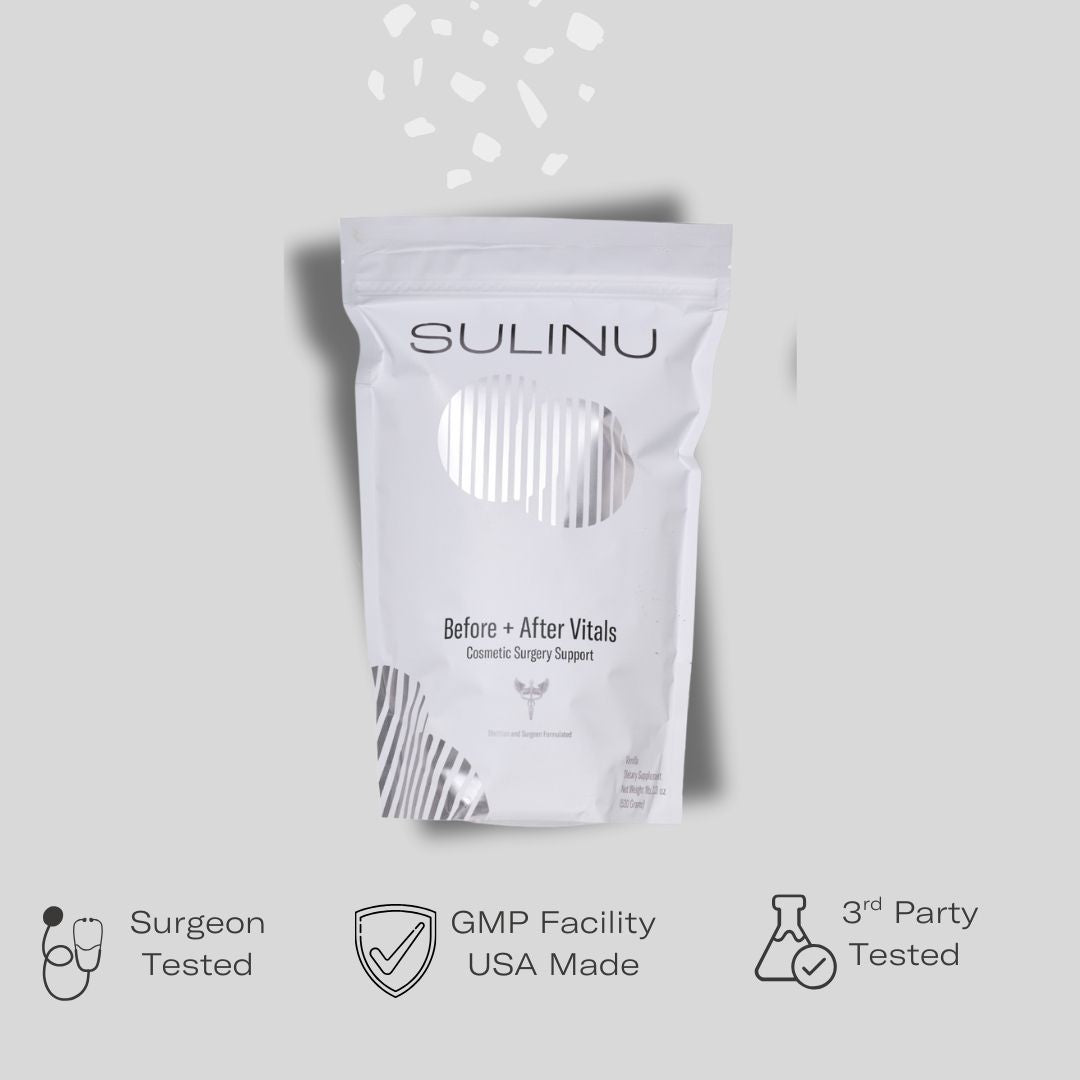
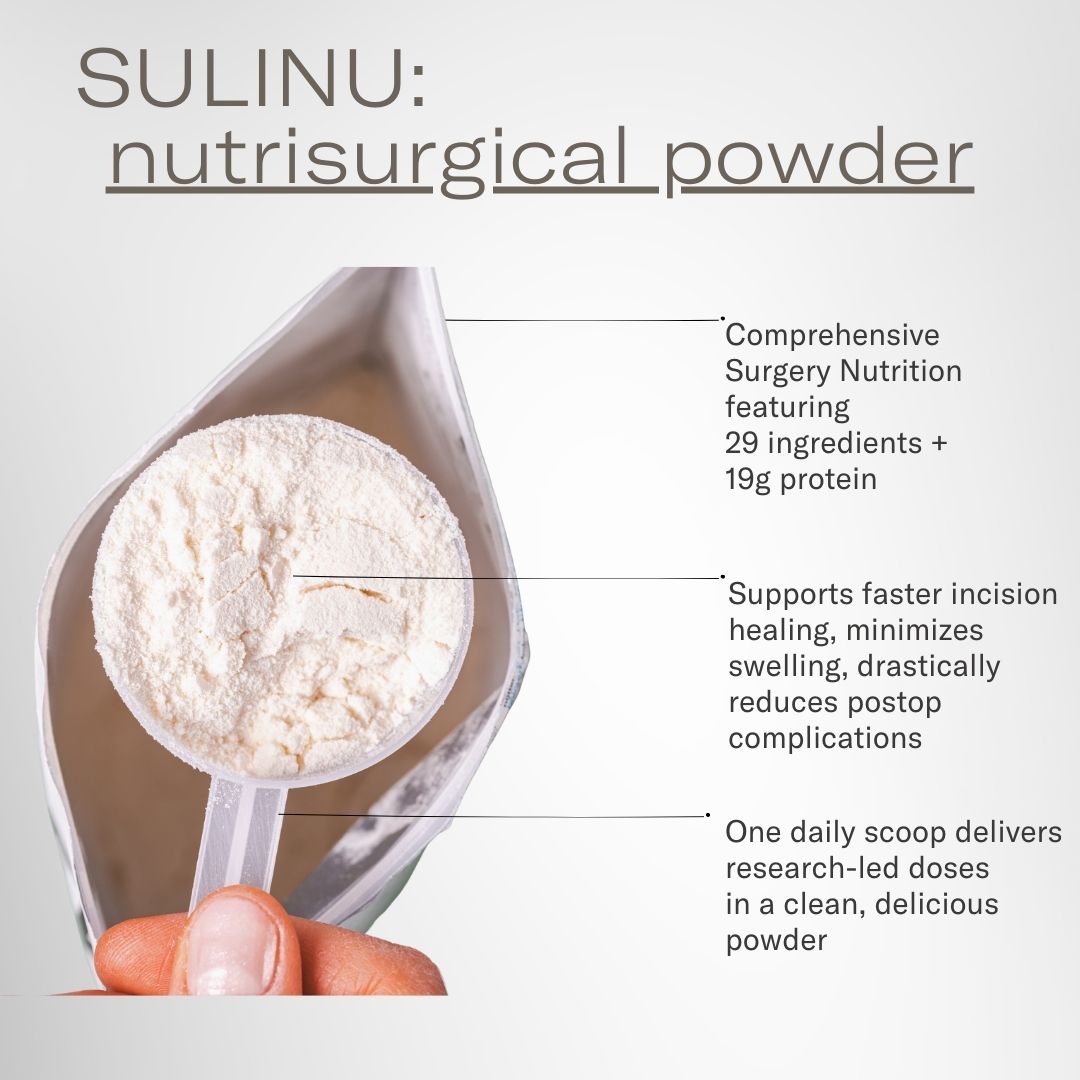
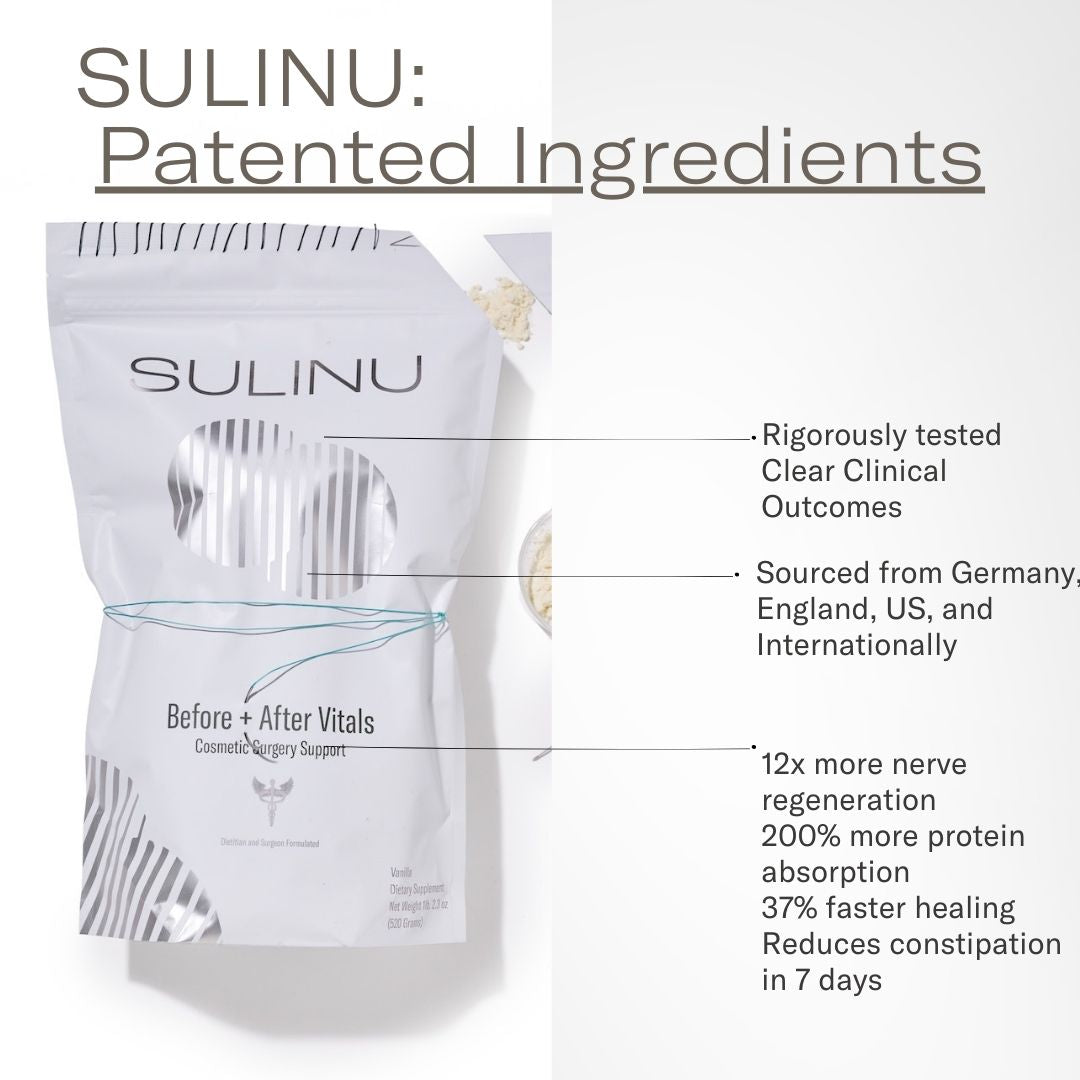
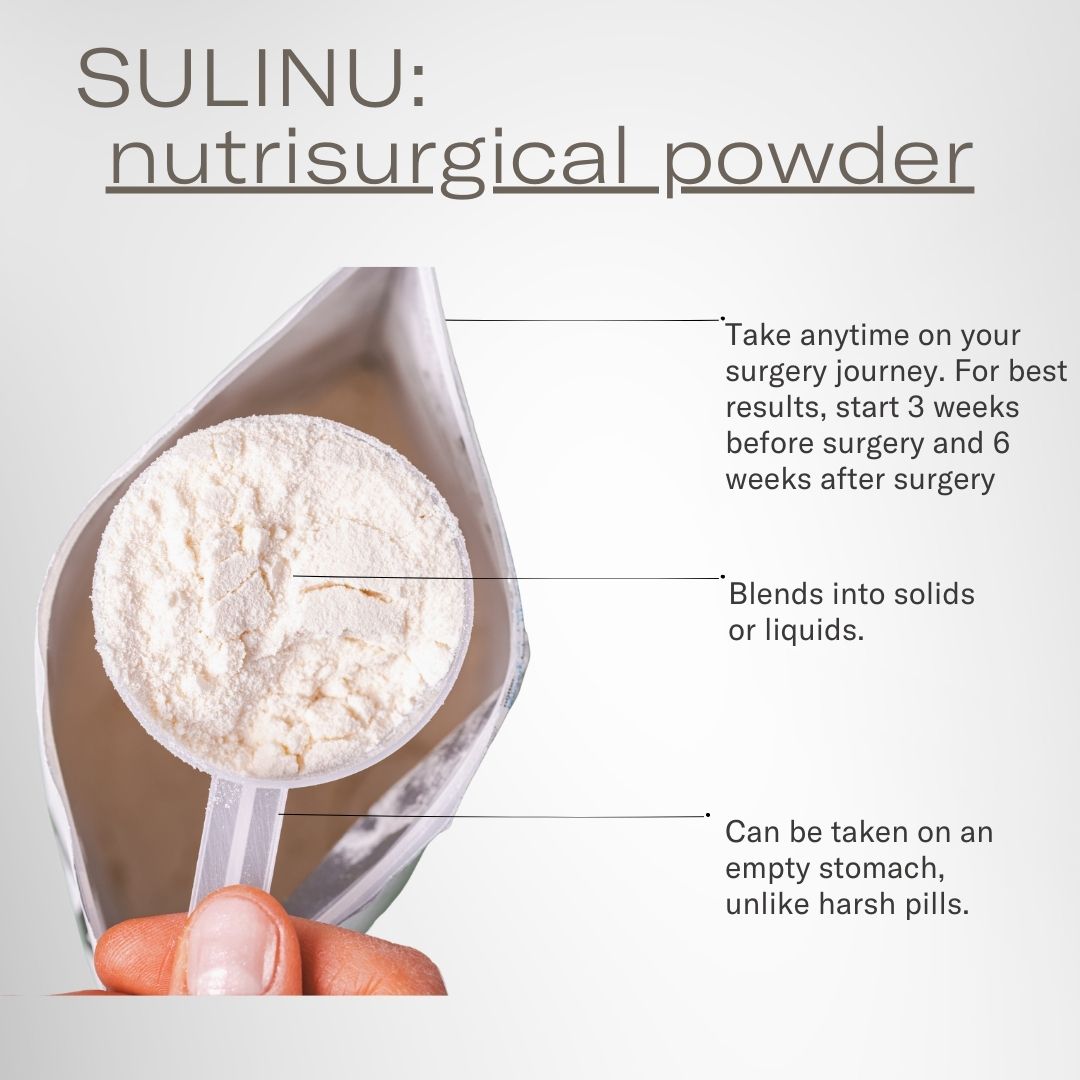
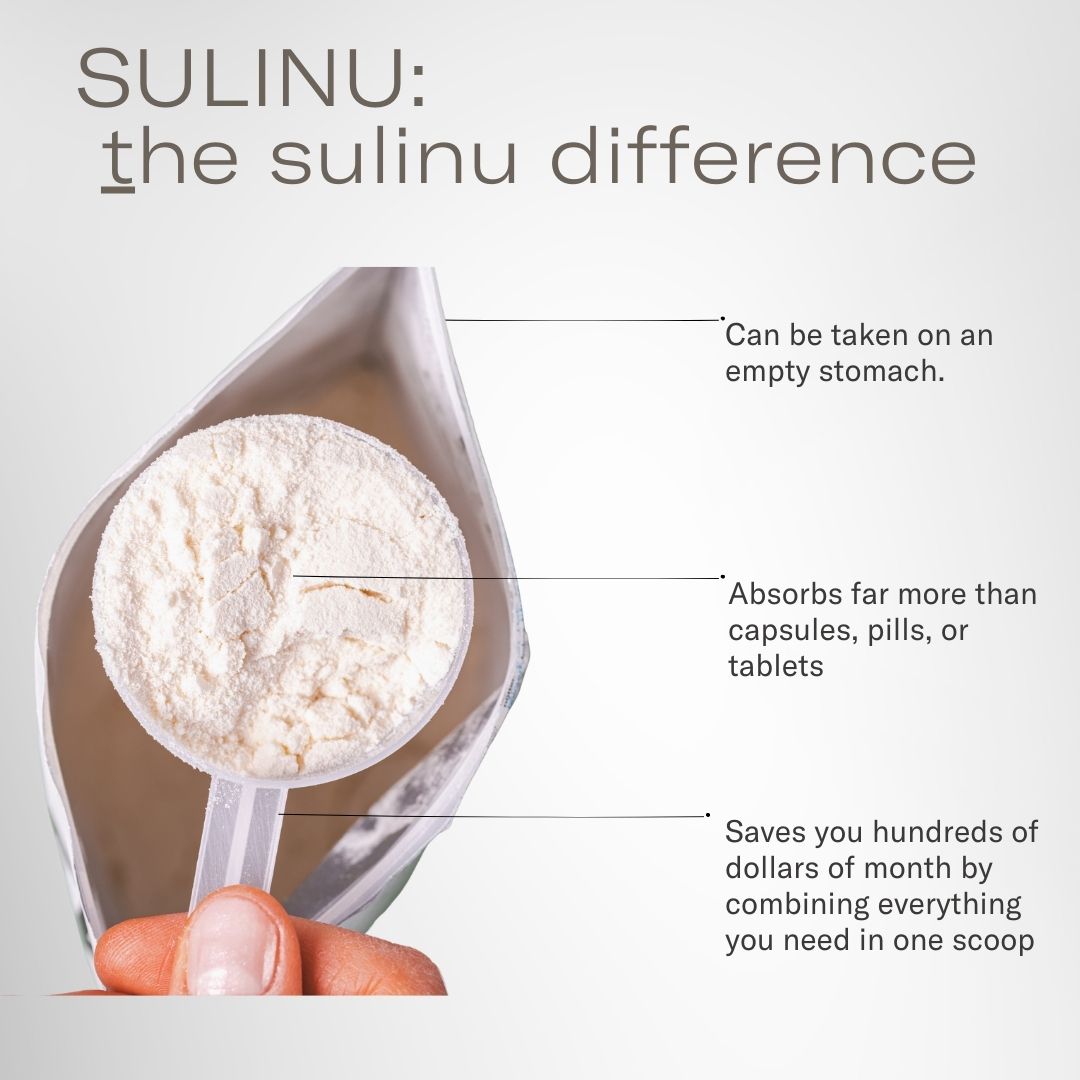
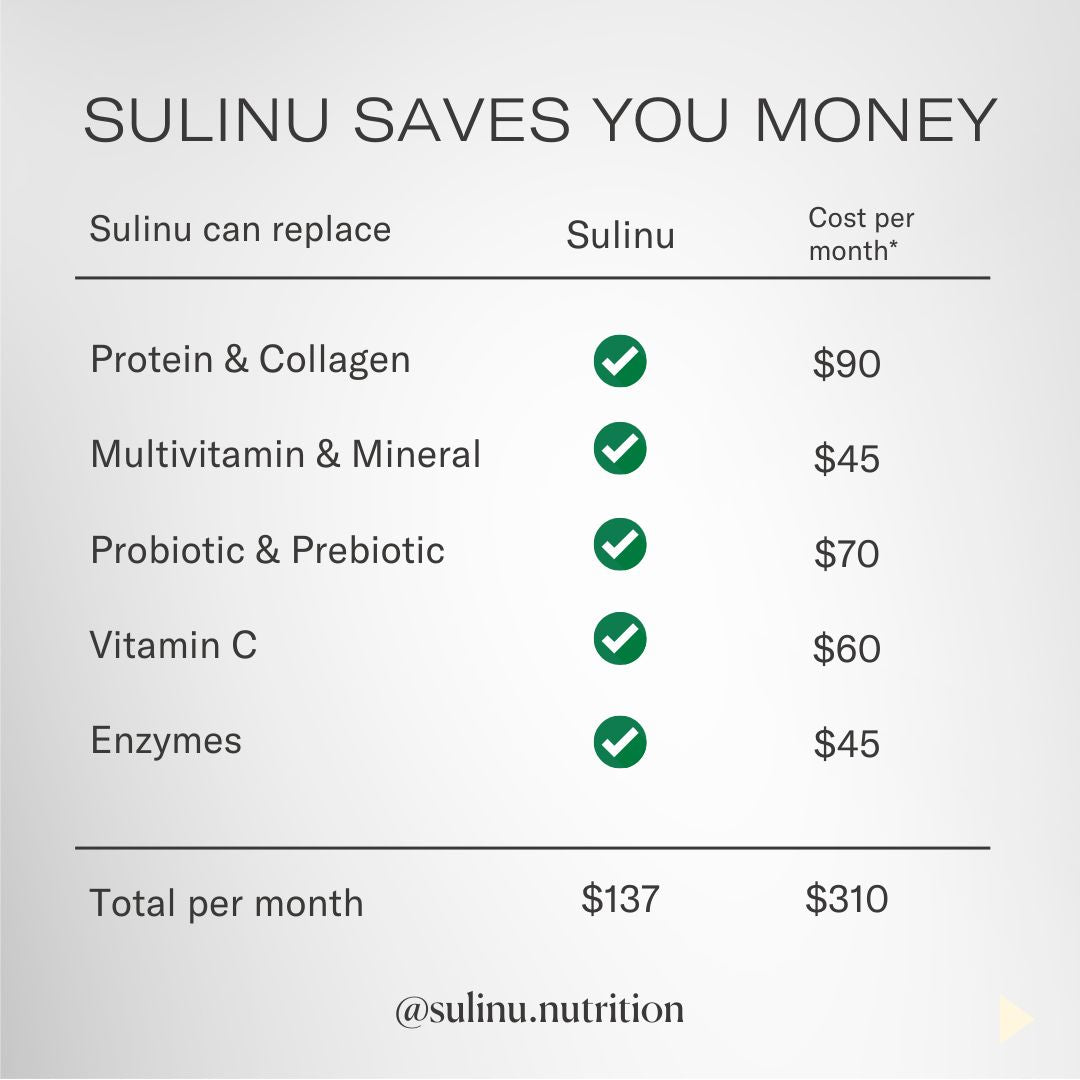
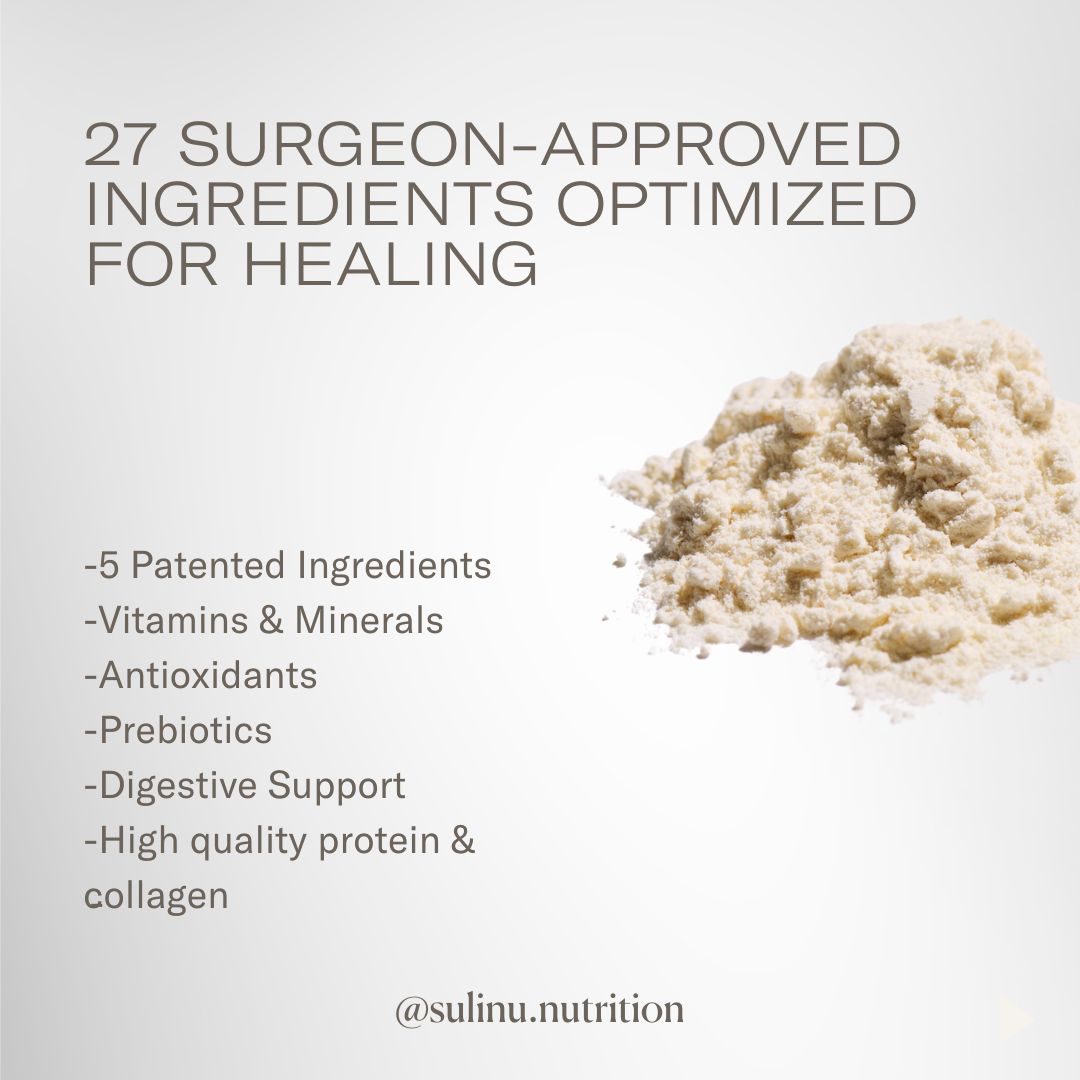
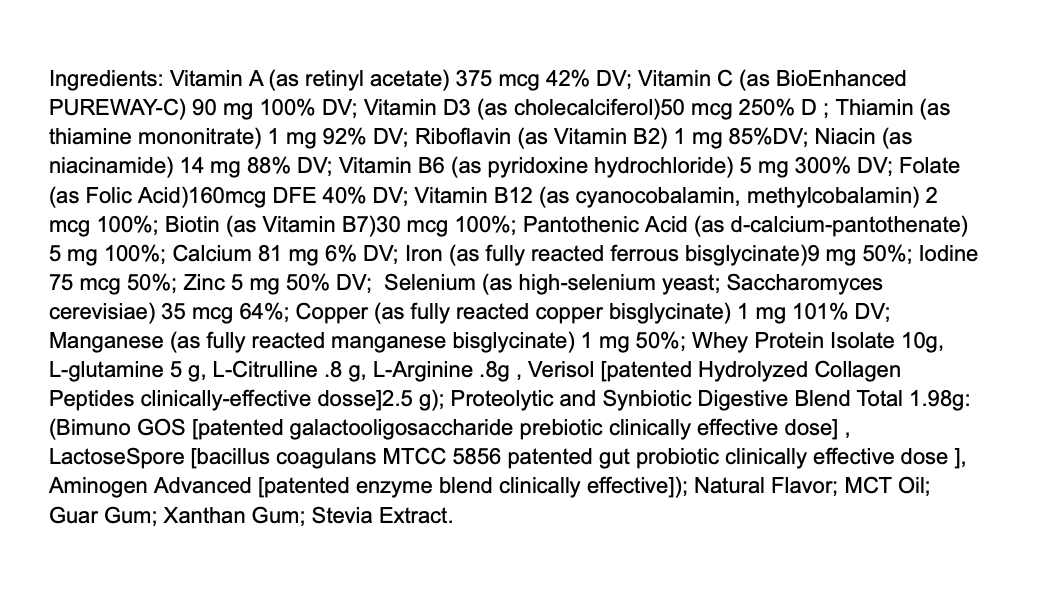
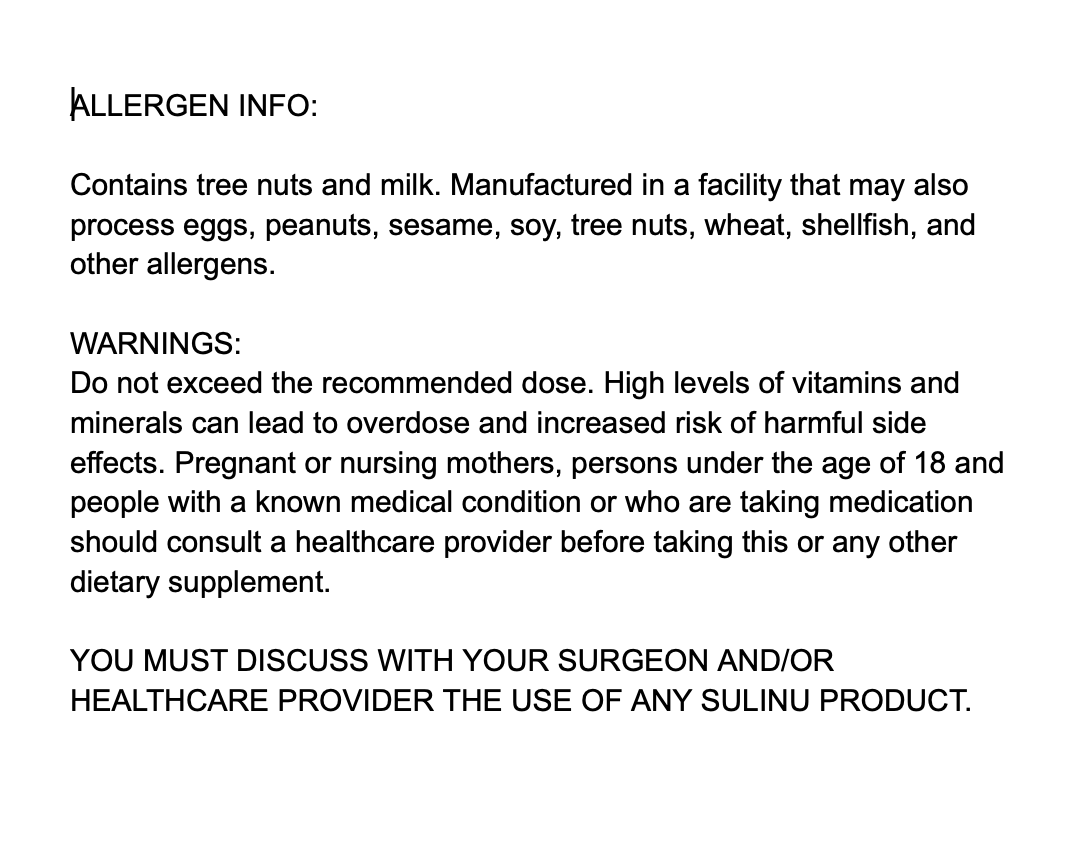
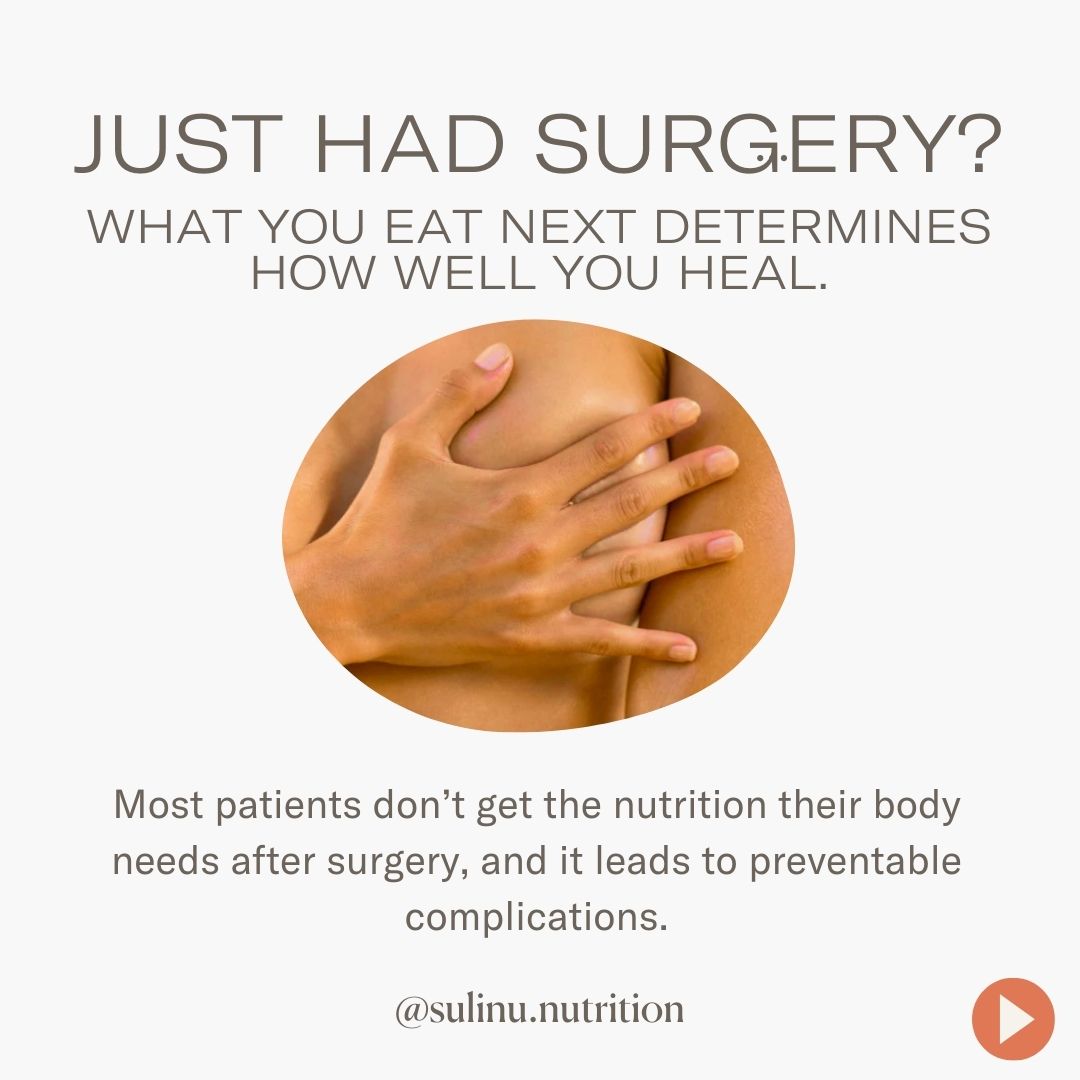

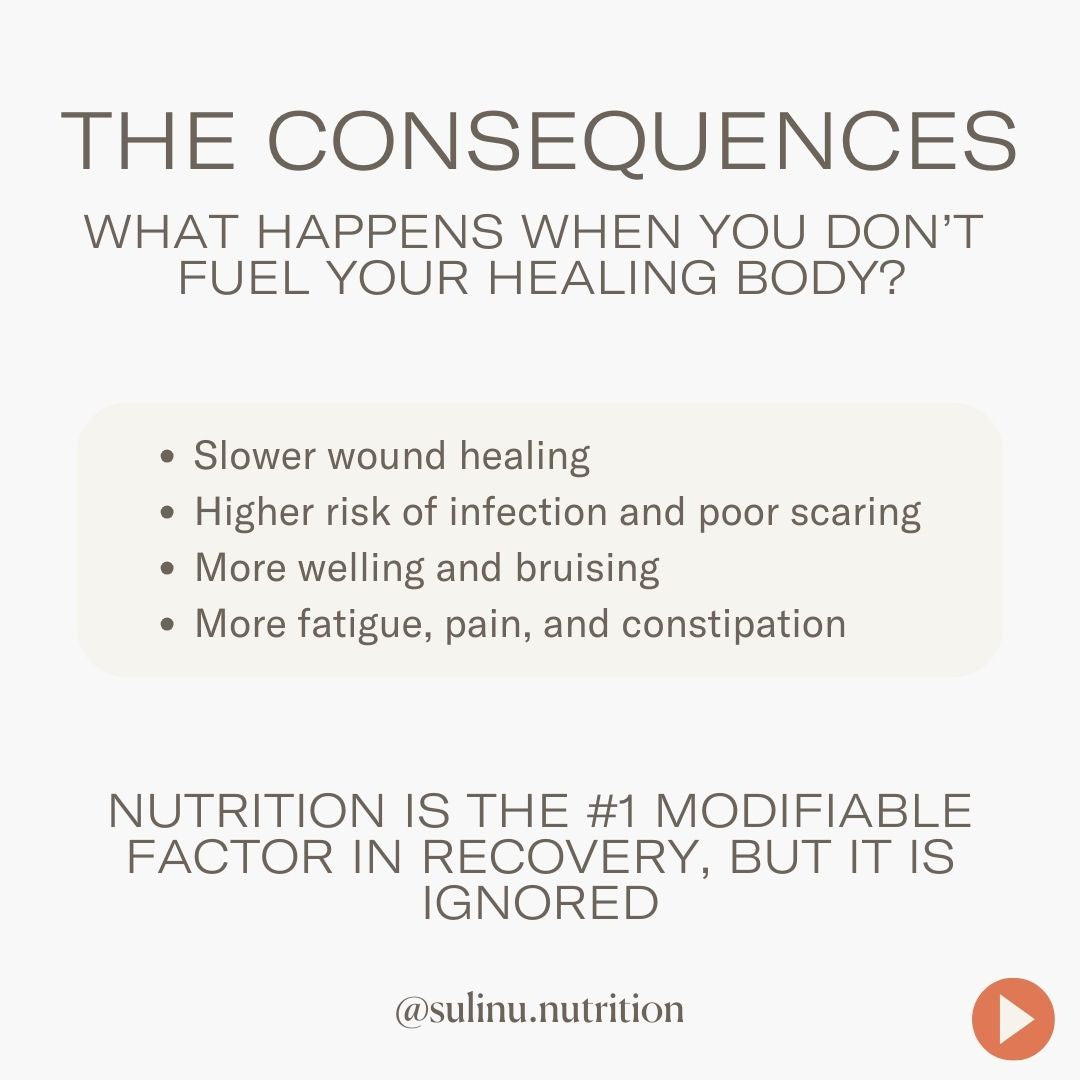
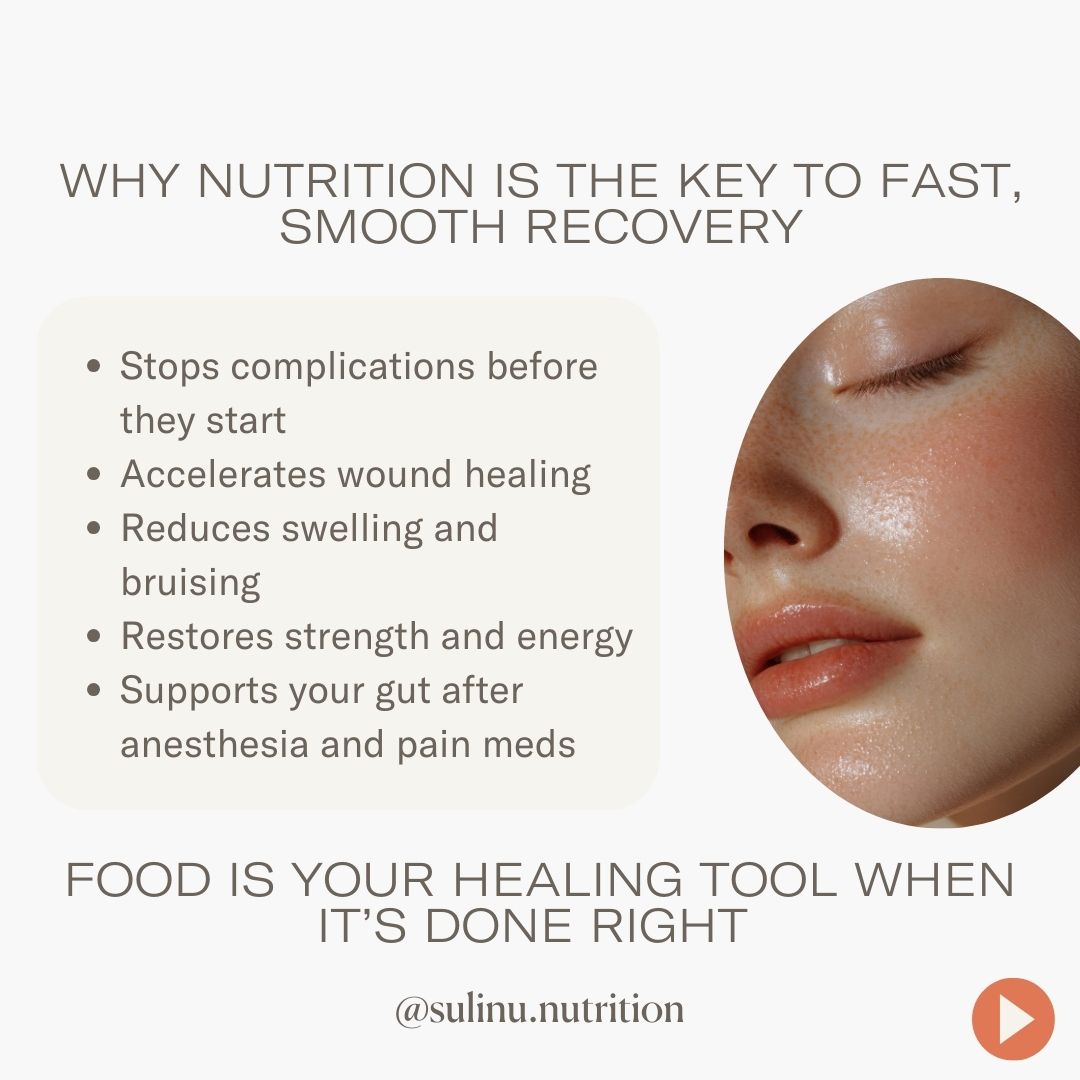
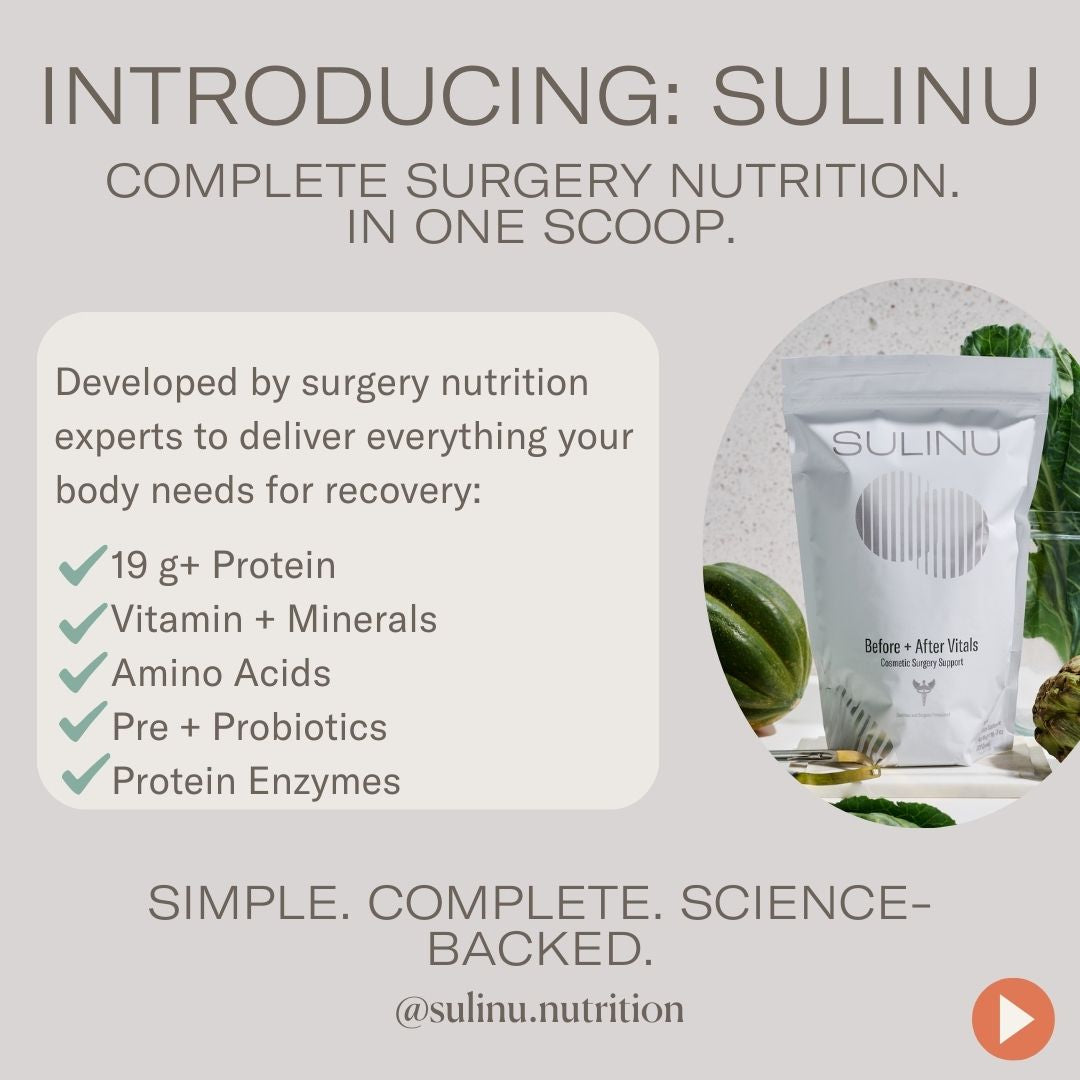
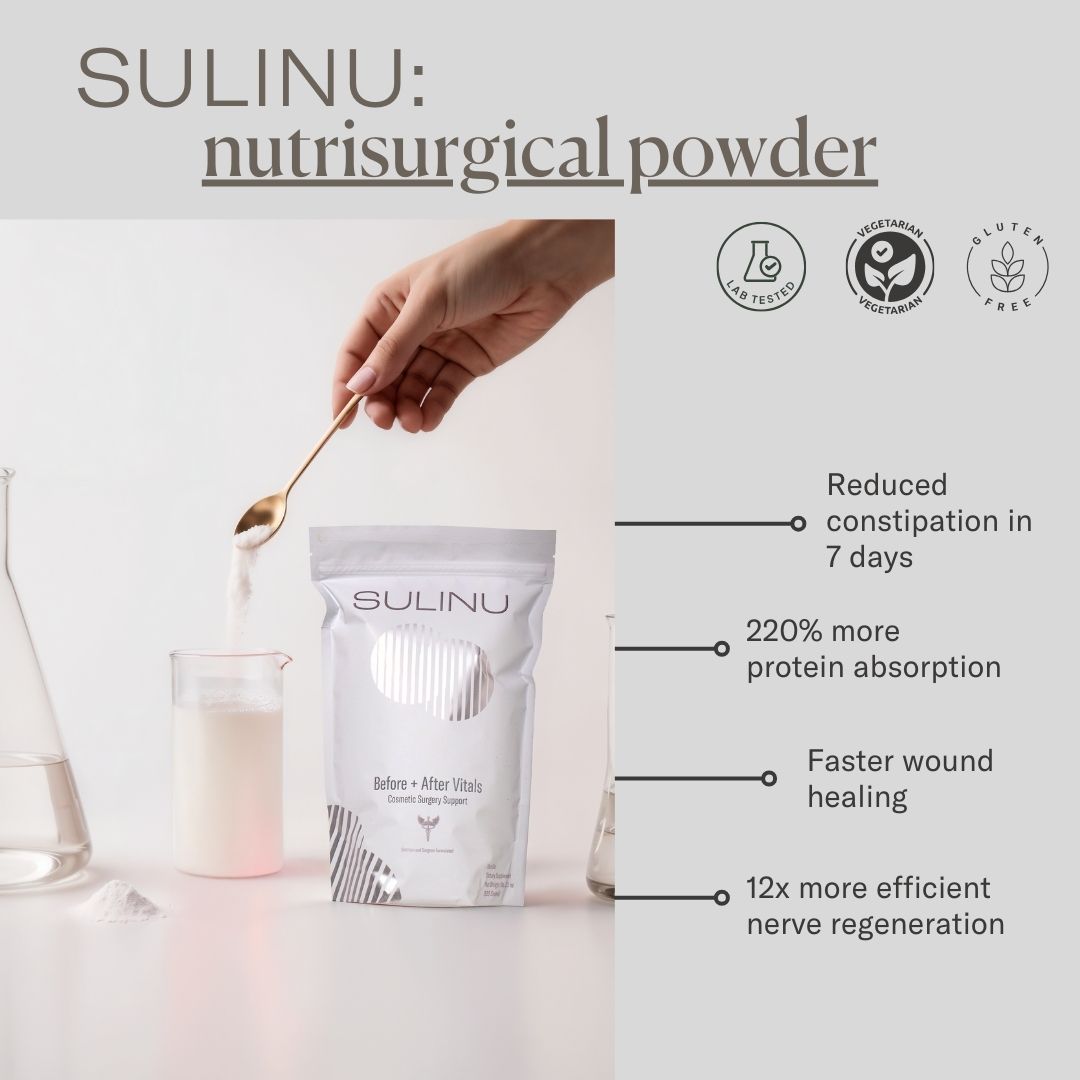
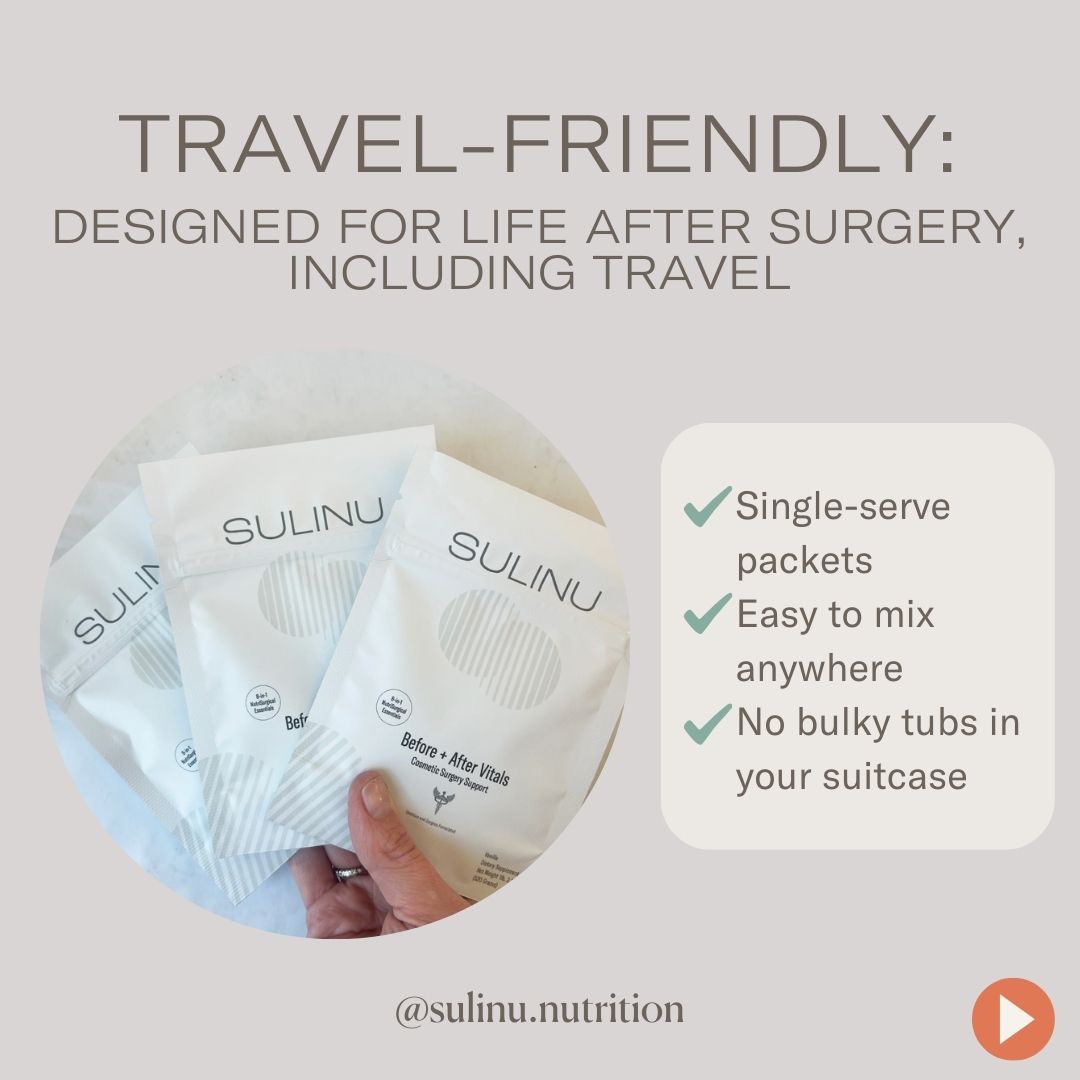
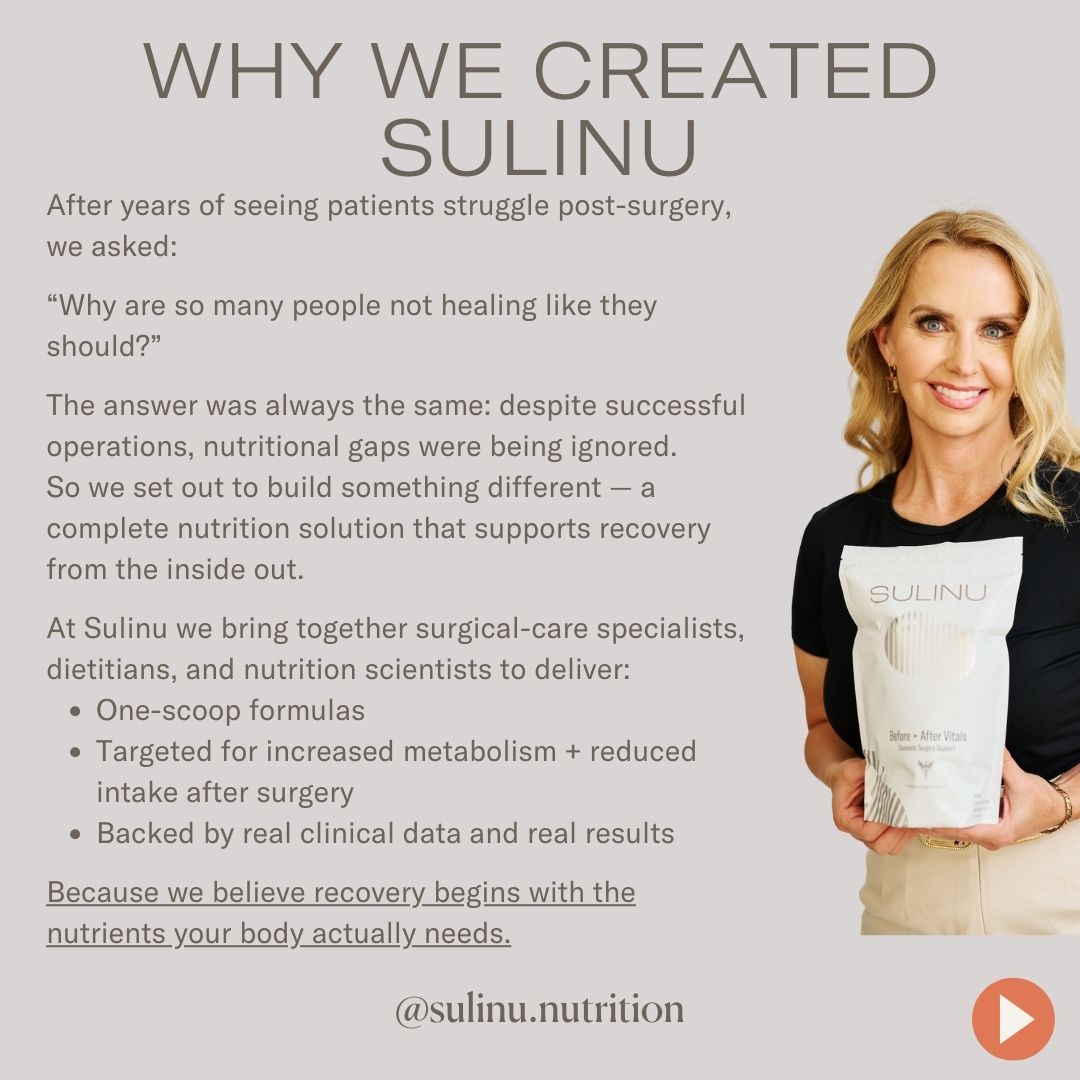
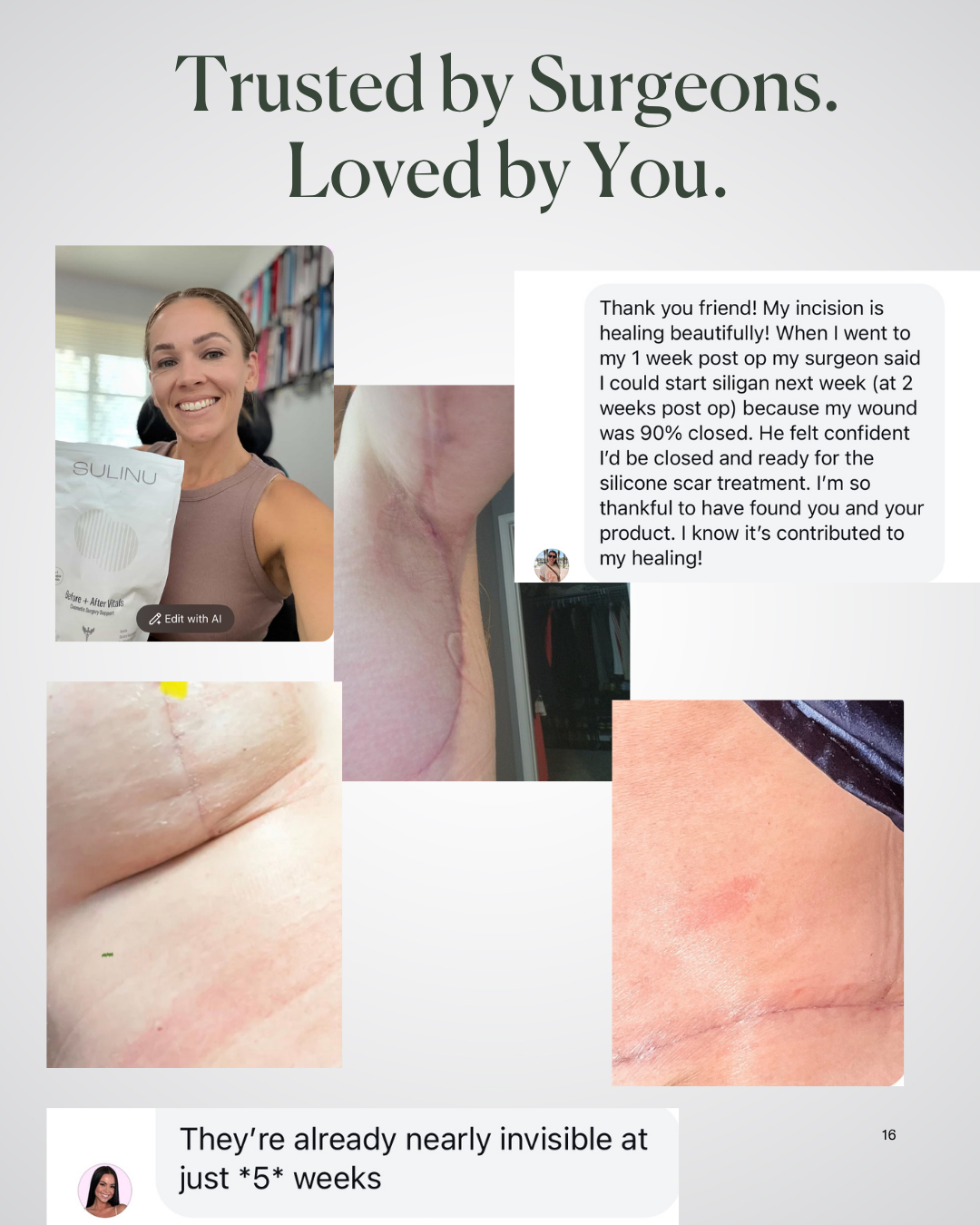
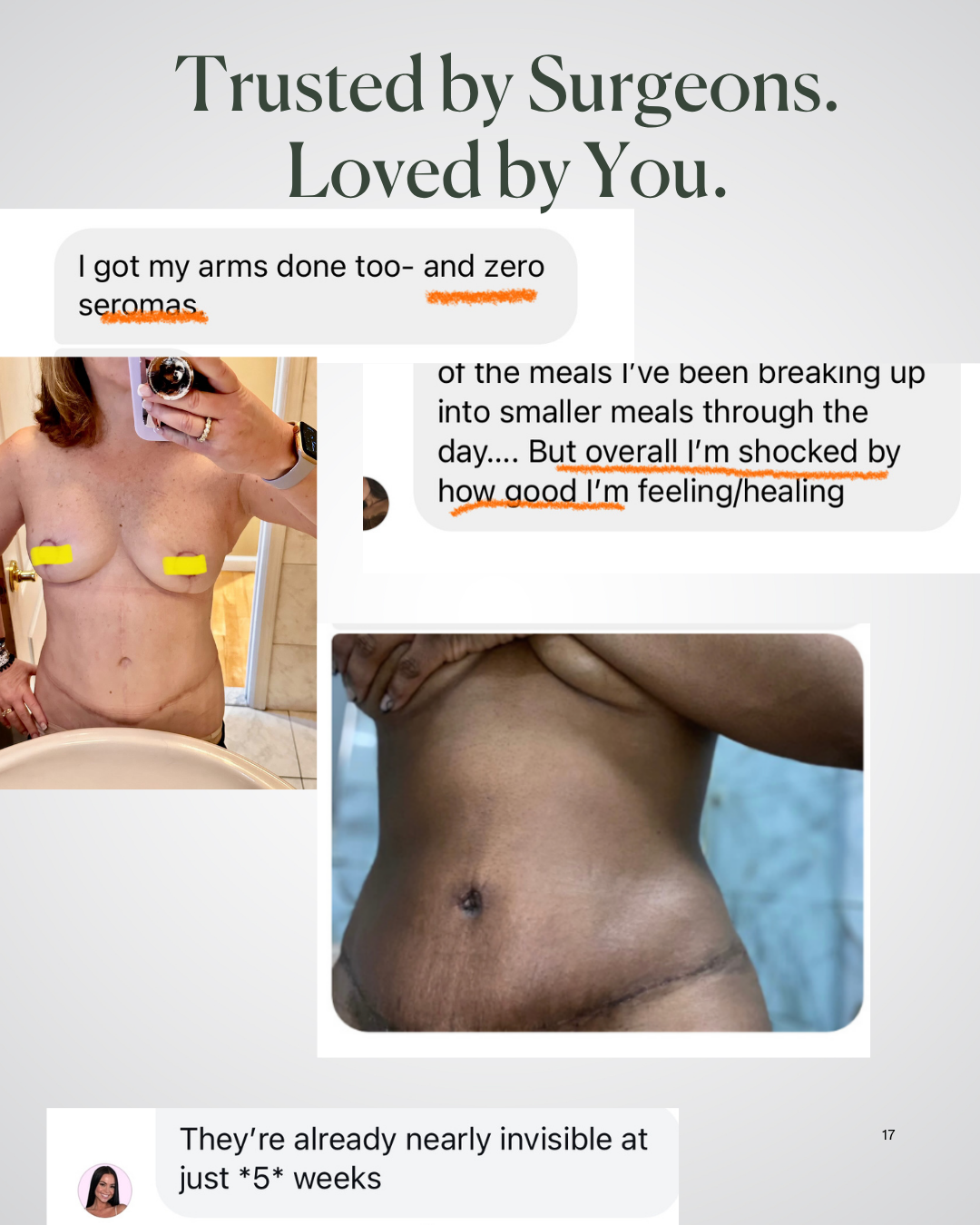
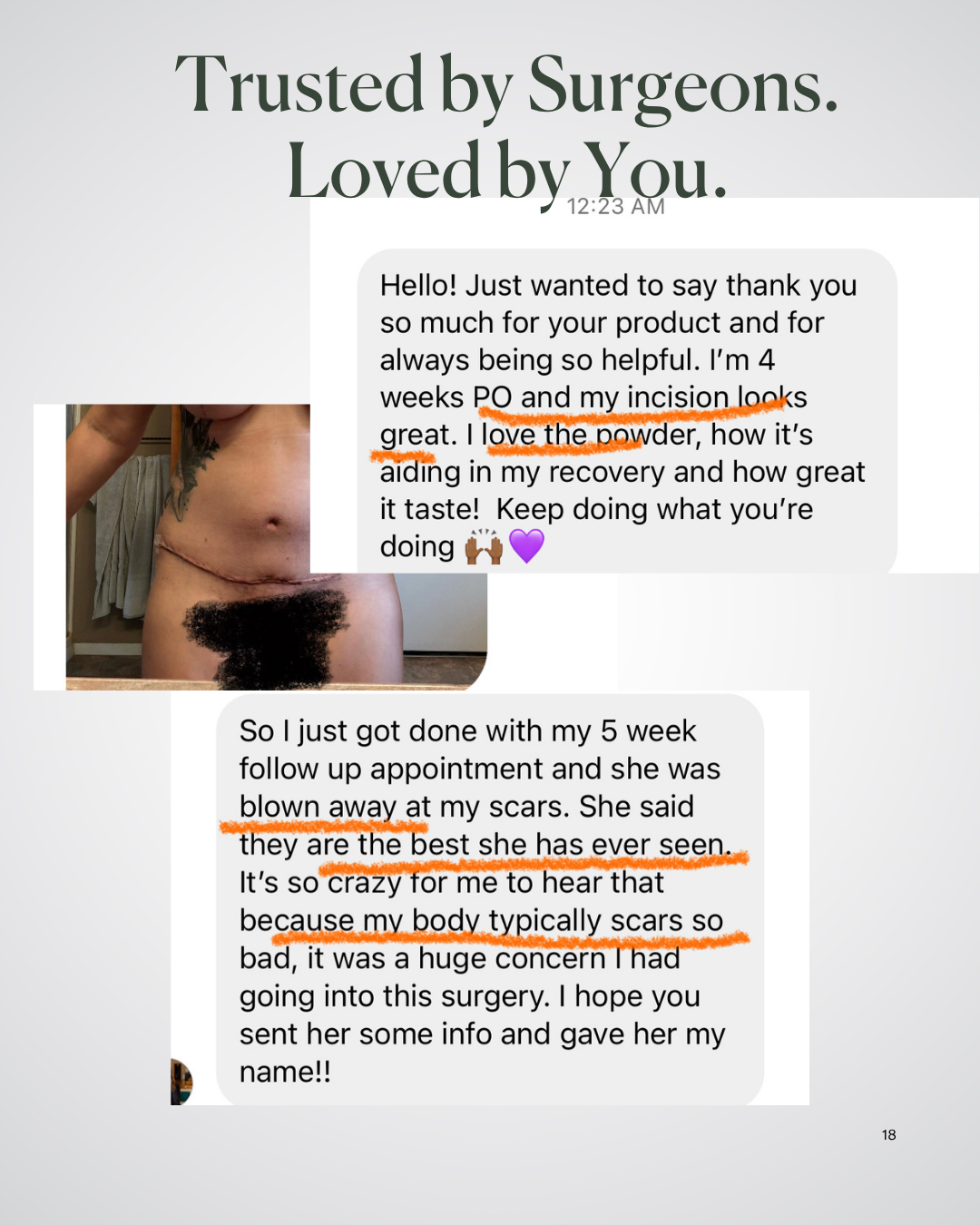
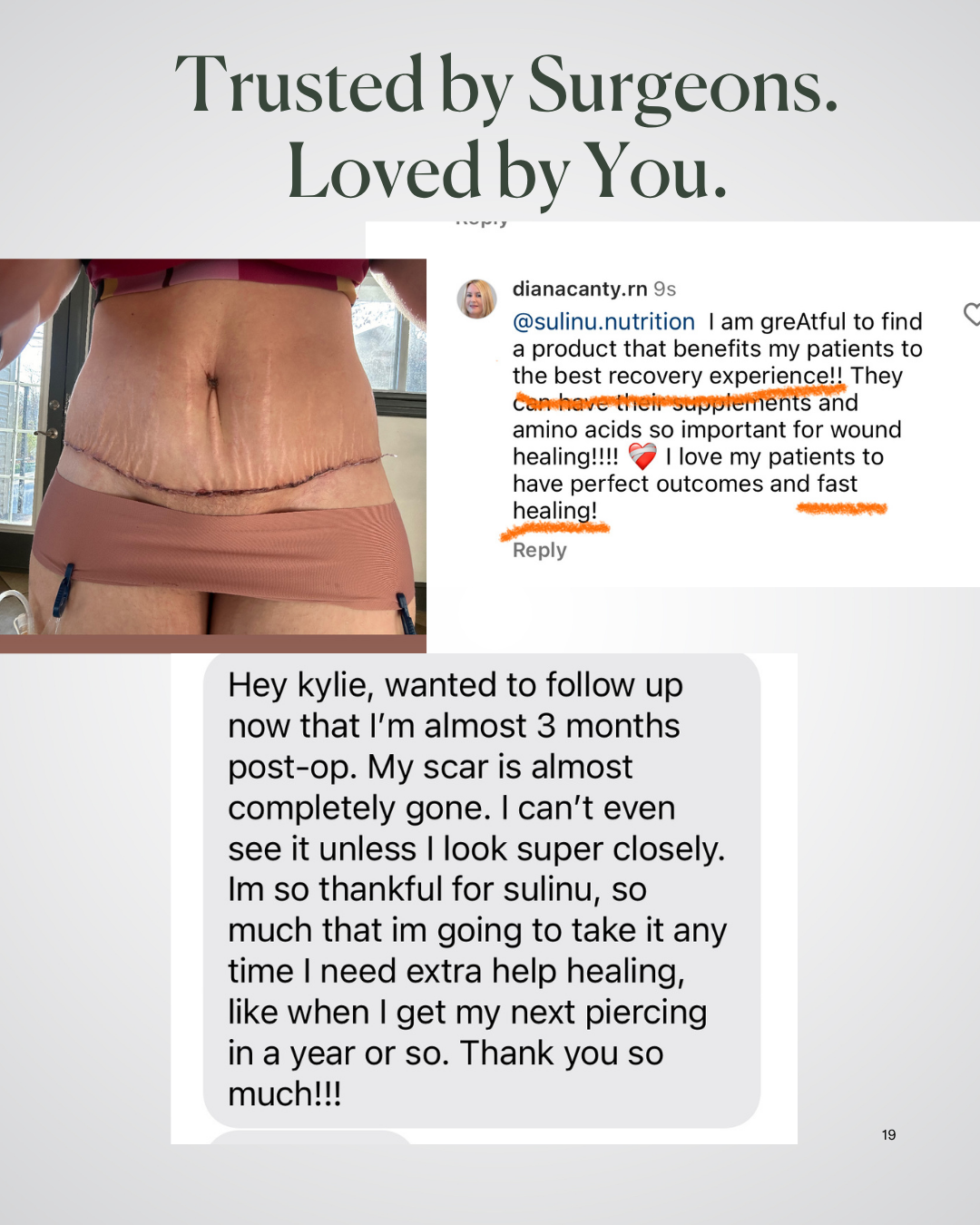
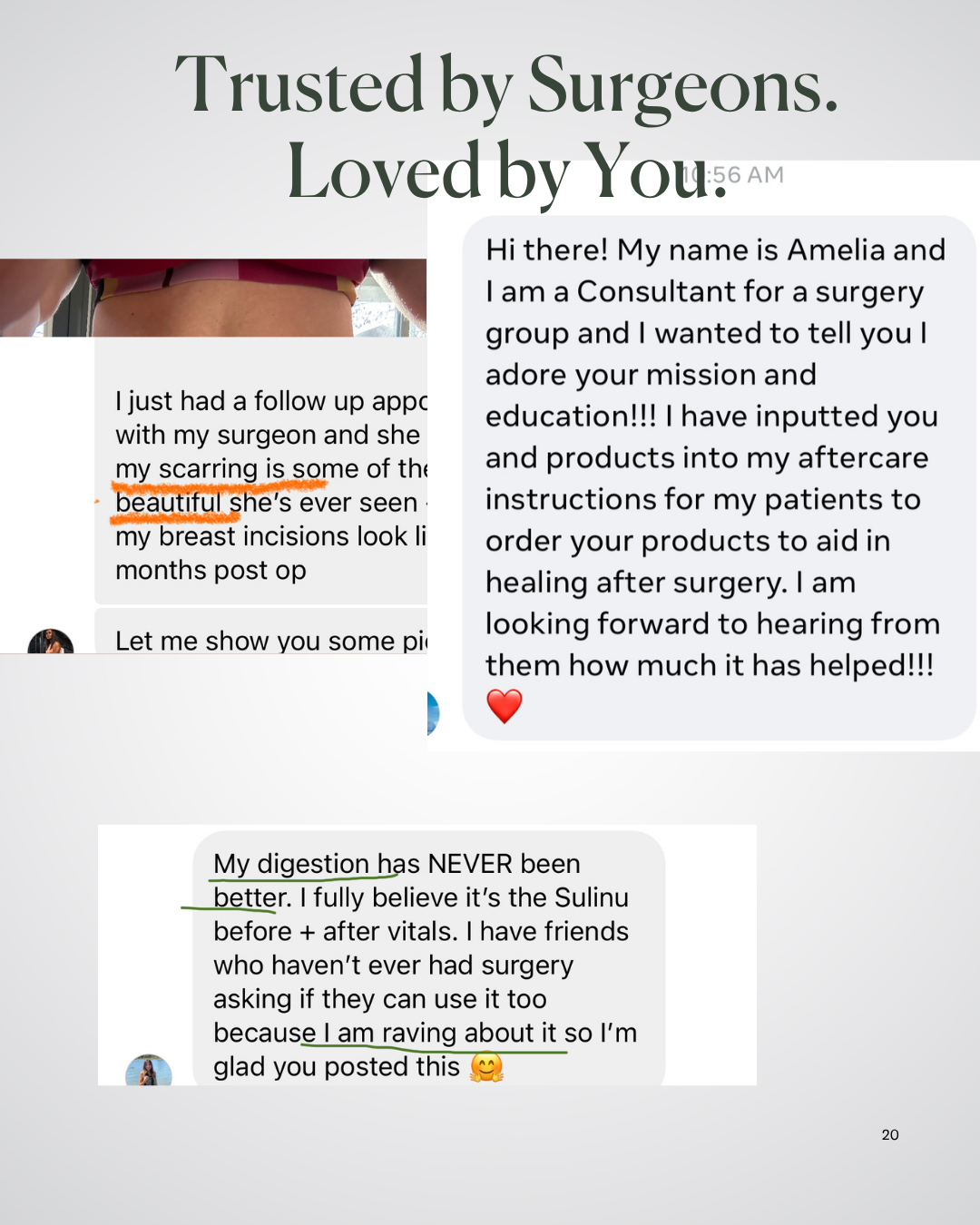
NUTRISURGICAL VITAMIN POWDER -(bag: Vanilla)
**FREE SHIPPING for orders over $150!!**
- 100% Money Back Guarantee
- Discreet Shipping-Your privacy is important
- We recommend 3 bags for any surgery for the best results
This Complete Surgery Powder gives you EVERYTHING you need IN ONE SCOOP.
Pre and Post Surgery Supplements for that near-invisible scar look.
"Can you believe it? [My incision scars] are nearly invisible at just 5 weeks!" -Jessie
Our pre and post surgery supplements are packed with vitamins for wound healing after surgery
- 3rd party tested
- Gluten-Free
- Vegetarian Whey
-
27 Surgeon-Approved Ingredients
- In bioavailable forms
-
5 Patented Ingredients
- Patented is the HIGHEST standard of ingredients
- Faster Incision healing
- Gut microbiome studied
- Clinically tested
- Sourced from Europe and Internationally
- Therapeutic Dosages
Perfect for:
- Before Cosmetic Surgery
- After Cosmetic Surgery
- Slow-to-heal incisions or wounds
- Using a GLP and needing extra nutrition
- Can begin taking at anytime on your surgery journey, EVEN if you are weeks after your surgery! Your scar is healing for a least a year after your surgery date.
How to use:
- Use 1/2 to 1 scoop a day. Max 1 scoop a day for at least 6 weeks postop.
- We recommend 3 bags: Use 1 bag before surgery and 2 bags after surgery
Nutrisurgical Vitamin Powder with Patented, Clinically-tested Ingredients.
All your Protein, Collagen, Amino Acids, MicroNutrients, Synbiotics and Enzymes in ONE SCOOP to give you a seamless recovery after cosmetic surgery.
Note: This product is also commonly used by GLP (Ozempic, Semiglutide, etc) patients to prevent nutrient depletion and Ozempic face
Our Survey Results*:
79% reported a beautiful incision
85% reported a faster recovery
90% liked the taste
X Gluten X Soy X Artificial Colors or Flavors X GMOs
*based upon our postop survey 2024
Introducing BEFORE + AFTER VITALS, the ultimate surgeon-endorsed nutritional supplement tailored exclusively for plastic surgery recovery.
Fears of infection, inflammation, slow-to-heal incisions, and bruising are taken head-on by this super fine, quick-to-dissolve powdered supplement. Add a delicious hit of vanilla flavor to your cold or warm drinks, smoothies, or culinary creations.
1 pouch is 20 servings.
ALLERGY info: Contains lactose. Product was processed in a facility that may also process eggs, peanuts, sesame, soy, tree nuts, shellfish, and other allergens.


